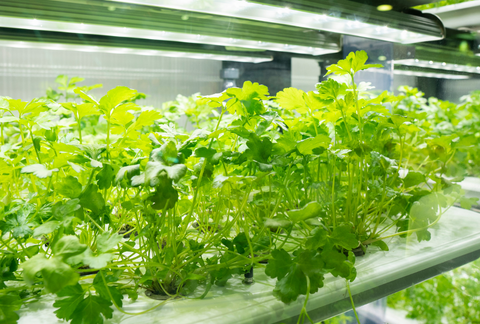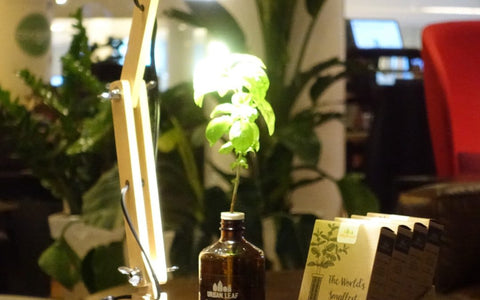In nature, plants use the duration of light (and darkness) to determine the time of year. The time of year is what dictates key plant reproductive behaviours such as flowering and fruiting. Since the goal of many indoor food growers is to get flowers, and ultimately vegetables or fruit, it's important to understand how the duration of light and darkness impacts your edible plants.
You might have the best watering, temperature, and fertilizer regime in the world. But if you get light durations wrong, you may struggle to control the flowering process - whether you're trying to encourage it (in the case of fruits and vegetables) or inhibit it (in the case of many herbs).
In the accompanying article to this one, titled ‘Plants Do Math At Night. How Long Should You Let Them Sleep?’, we looked at why giving plants a daily rest period is critical, and some of the important biological functions they perform when the lights are out.
In this article, we continue the conversation into grow lights, and more specifically we address the question of how long you should be leaving your grow lights on for each day.
We've broken this article into two main parts:
- A 3-Step Process that you can use to calculate the optimum light intensity for your plants, and
- A free online spreadsheet that you can use to help with your own math.
Let’s jump in.
Step 1 – Understand The ‘Ideal’ Hours Of Light Per Day For Your Plants
Short vs Long Day Plants – How Their Light Needs Differ
In the plant world, scientists refer to plants as being either “long” or “short” day plants.
- LONG-day plants need SHORT periods of darkness to flower. Common examples of LONG day plants include basil, cilantro, parsley, dill, mint, and tomatoes.
- Conversely, SHORT day plants need LONG periods of darkness to flower. Common examples of SHORT day plants include avocado, mustard greens, marigold, zinnia, and strawberry.
So theoretically, if you wanted to emulate a plant’s ideal growing environment, then all you’d need to do is look up its ideal day length and use that to set the on/off timer on your grow light.
The problem with this approach however is that it’s likely to lead to your plants flowering quickly. For some plants, e.g. tomatoes and peppers, that’s a good thing – because the flower is what ultimately produces fruit. But for other plants, such as lettuce and cilantro, flowering is the beginning of the end. Leaves will also change shape, their taste can become bitter, and at this point, most gardeners will pull them out and start over.
In addition to classifying plants as either short or long days, we can also classify them based on whether flowering is desirable, or undesirable.
Using Light Duration To Promote (or Avoid) Flowering
So for plants where flowering is desirable, you want to give your plants their ideal light duration. For plants where flowering is undesirable, you should do the opposite. We find it is useful to break the plant world down into four quadrants at this point.
| Long Day | Short Day | |
| Flowering Desirable |
Provide a long day, since we want flowers:
|
Provide a short day, since we want flowers:
|
| Flowering Undesirable |
Provide a short day, to avoid flowering:
|
Provide a long day, to avoid flowering:
|
Is There A Limit To How Long You Can Leave Lights On For?
Short answer: yes. Even the long-day plants, where flowering is desirable, do have their limits. As we explained in ‘Plants Do Math At Night. How Long Should You Let Them Sleep?’ plants do require a daily respiration period of at least 6 hours per day (for seedlings) and ideally 8-10 hours for more mature plants. Therefore we do not recommend providing more than 14-16 hours per day of light, even if you are growing long-day-loving varieties and trying to induce flowering/fruit from them.
Step 2 – Understand The ‘Ideal’ Daily Light Integral (DLI) Requirements For Your Plants
Not only do plants have an ideal duration of light each day, but they also have varying needs in terms of the ‘volume’ of light that they accumulate per day. This ‘volume’ of light is measured via a term called ‘Daily Light Integral’ or DLI. (check out ‘Grow lights For Indoor Plants – How To Measure It, and Understanding Watts, PPF, PPFD, and DLI’ if you’d like to learn more about this topic).
Decorative indoor plants like the popular pothos, snake plants, or monstera might be content with a DLI of 1-4 mol/m2/day, but most edible plants will need a DLI somewhere in the 10 – 30 mol/m2/day range.
Side note: DLI is a measure of how much light energy falls on a surface (say, a plant leaf) in a 24 hr period. Where you and I have a certain number of calories we need each day to keep us going (some of us more than others), plants all have their own DLI requirements. Failing to give a plant sufficient DLI over an extended period will have the same effect as failing to give you enough calories. At best, you’ll get hangry. At worst, you could perish.
Step 3 – Calculate The Ideal Light Intensity (PPFD) Requirements For Your Plants
Once we know a) the total volume of light that a plant needs to be happy, and b) the ideal time/duration in which we should deliver it, then we can simply divide one number by the other in order to calculate the ideal delivery rate of that light. This is exactly the same math you would use if I told you we had a 10-gallon bucket and it needed to be filled over a 5 hr period. You’d simply divide 10 by 5 to deduce that you needed to be filling the bucket at 2 gallons per hour.
Where we measure the rate of water flow in gallons (or liters) per hour, we measure the rate of flow for light in PPFD (photosynthetic photon flux density) in moles per meter squared per second, or mol/m2/s.
We’ve summarized this math for you in the table below. If you’re interested in a plant that’s not listed here, please leave a comment and we’ll do our best to find an answer for you and add it to the table.

Other Considerations in Determining How Many Hours a Day Are Needed for Indoor Plant Grow lights
Other considerations to keep in mind when determining how long to leave your Grow lights on for indoor plants include:
- Delivering the target DLI in too short a time period requires a high rate of flow (PPFD). Just like you can get sunburned, plants can also get ‘light burned’. Subjecting plants to excess PPFD is likely to cause their leaves to go brown.
- If you are having trouble getting a plant to flower (and you want it to flower) try very gradually to modify the day length. Gradually shortening day-lengths can ‘trick’ plants into thinking that the end of the growing season is approaching and winter is coming. They’ll want to get their fruit produced before that happens.
- Plants need to sleep. They perform important respiratory functions at night. Seedlings should have at least 6 hours of darkness per day, and more mature plants at least 8-10 hours a day.
We hope this guide to indoor edible gardening and grow lights has been useful. The next logical step from here is to take what you’ve learned about ideal PPFD and use that to determine the placement and type of grow light you need. If you’d like to learn more about this topic we recommend reading How Far Should Grow Lights Be From Plants as well as signing up for our email list below.
If you're ready to start enjoying the many benefits of growing indoors with a grow light, then here are a few of our favorite options.
- Best Hanging Option: If you have a wall or ceiling from which to hang your light, then the Aspect grow light is the way to go. It comes in white and black, as well as 20W or 40W.
- Best Free Standing Option: If you'd rather not be drilling holes in your ceiling/wall, then a great alternative is to get a free standing option like the PlantSpectrum. The small is 16" and 16W, and large is 32" and 32W. They are not only incredibly versatile in terms of mounting options, but they have the added benefit of being water proof.
- Best Under-Cabinet Option: If you're looking to grow on a bookshelf or countertop, then you should definitely check out the Grove. It has a number of mounting options (like the PlantSpectrum) and comes in at a more affordable price point.
- Most Versatile Option: If you live in a rental, move around a lot, or just want future flexibility - then a Vita is your best bet. This is available as both a stand-alone globe, as well as in a pendant kit. We also offer options in black/white and narrow/wide beam angle. It's E26 fitting is compatible with any standard screw-style housing (i.e. desk lamp, lamp stand, or pendant light).
- Best Budget Option: If you're just looking for something cheap and simple for seed starting or a single herb plant, then we do also offer a compact option. This unit is not suitable for large grow areas or fruits/vegetables, however.











Hello geturbanleaf.com webmaster, Your posts are always informative and up-to-date.